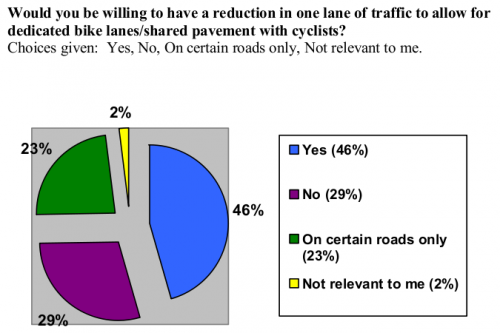By local band Rural Alberta Advantage, video directed by Kristofer Delaney. Perfect song for riding yer bike this summer.
Btw, they play at the Horseshoe on July 30th.

Peter Milczyn, City Councillor for Etobicoke - Lakeshore has results for an unscientific survey of ward citizens and their cycling habits and views. We don't know how many people responded to the survey, and those who did respond are pre-selected to want to respond and perhaps liked Milczyn. Still there are some interesting trends for a Toronto suburb.
Some highlights:
- 90% own a bike
- 27% commute by bike
- 61% use existing bike lanes
- 41% would ride on a road with no bike lane, 39% only at certain times of day
- 55% fully support bike lanes, 26% in some locations
- most suitable locations for bike lanes: local roads 14%, collector roads 14%, minor arterial roads 19%, major arterial roads 12%, pathways and parks 22%, mixture of above 16%, nowhere 3%
- 38% see cyclist safety as the biggest concern with bike lanes, 16% see increased traffic congestion, 32% see disjointed bike lanes as biggest concern
- 58% would bike more often if more bike lanes were introduced
- 65% of drivers willng to share roads with cyclists
- 46% willing to give up a lane of traffic for dedicated bike lane, 23% only on certain roads
- with increasing price of gas, those that will consider switching from car commuting to cycling - 22%, public transit 24%, car pooling 8%, other 6%, not relevant 40% [not relevant because they don't commute by car?]
- the intersections of the greatest concern for pedestrians: Six Points interchange, Bloor St. W. at Royal York, Kipling, Islington
- 70% feel bicycles should not be required to register as a road user and pay a fee
- 53% feel that Bloor bike lanes west of Kipling are beneficial, 19% say time will tell
- 9 comments
San Francisco is looking at how Toronto cyclists deal with streetcar tracks. The answer: not very easily. Toronto streetcar tracks have been the bane of many cyclists, both experienced and green. Being one of just a handful of North American cities with streetcars, Toronto could provide valuable information.
What can San Francisco learn from the Toronto experience? What ways can cities improve the safety for cyclists crossing tracks?
Experienced bicyclists tend to figure out the best way to navigate the tracks, but what can be done to prevent less-experienced bicyclists from getting stuck in the rail depressions so regularly?
In Toronto, where bicyclists also have to contend with a maze of tracks, several at-grade railroad crossings are equipped with a rubber flange filler that is jammed down into the cracks of trolley tracks. The rubber is firm enough that it doesn't compress when a bike passes over it, but when a streetcar comes it squishes down and doesn't cause the train to derail.
The material is not used for Toronto's extensive network of streetcar tracks in the city's core, however, and bikes routinely get caught in the tracks. "The at-grade railroad crossings do have some of that incorporated, but certainly not the main hazards to cyclists, which are the arterial road streetcar tracks," said Yvonne Bambrick, Executive Director of the Toronto Cyclists Union.
"There’s a lot of places where several tracks meet and turn. They’re trickier to navigate, but folks that have been at it for a while have figured out how to do it. It’s not that hard: you pay attention and learn how to do it, it’s all good. It does catch people fairly regularly."
- ‹ previous
- Page 215
- next ›
